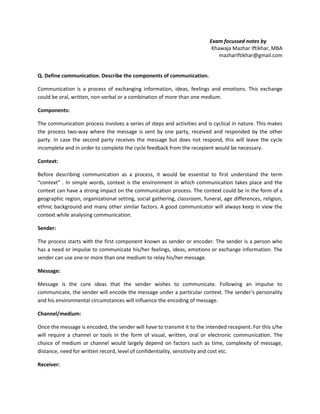
Communication Cycle Notes
- 1. Exam focussed notes by<br /> Khawaja Mazhar Iftikhar, MBA<br />mazhariftikhar@gmail.com <br />Q. Define communication. Describe the components of communication.<br />Communication is a process of exchanging information, ideas, feelings and emotions. This exchange could be oral, written, non-verbal or a combination of more than one medium.<br />Components:<br />The communication process involves a series of steps and activities and is cyclical in nature. This makes the process two-way where the message is sent by one party, received and responded by the other party. In case the second party receives the message but does not respond, this will leave the cycle incomplete and in order to complete the cycle feedback from the recepient would be necessary.<br />Context:<br />Before describing communication as a process, it would be essential to first understand the term “context” . In simple words, context is the environment in which communication takes place and the context can have a strong impact on the communication process. The context could be in the form of a geographic region, organizational setting, social gathering, classroom, funeral, age differences, religion, ethnic background and many other similar factors. A good communicator will always keep in view the context while analysing communication.<br />Sender:<br />The process starts with the first component known as sender or encoder. The sender is a person who has a need or impulse to communicate his/her feelings, ideas, emotions or exchange information. The sender can use one or more than one medium to relay his/her message.<br />Message:<br />Message is the core ideas that the sender wishes to communicate. Following an impulse to communicate, the sender will encode the message under a particular context. The sender’s personality and his environmental circumstances will influence the encoding of message.<br />Channel/medium:<br />Once the message is encoded, the sender will have to transmit it to the intended recepient. For this s/he will require a channel or tools in the form of visual, written, oral or electronic communication. The choice of medium or channel would largely depend on factors such as time, complexity of message, distance, need for written record, level of confidentiality, sensitivity and cost etc.<br />Receiver:<br />The receiver’s first task on receiving the message is to interpret the codes he sees in the form of language or meanings hidden therein. Like the encoder, the decoder interprets the message under a particular context. The decoder’s personality and his/her environmental circumstances will influence his/her understanding and interpretation of the message.<br />Feedback:<br />Feedback is the reaction of the receiver to the sender’s message. With feedback, the cycle of communication also gets completed. Feedback is the most important step in the entire process as it will determine the effectiveness of a message and also guard against the so many potential barriers and breakdowns in communication.<br />…………………………………………………………..<br />
